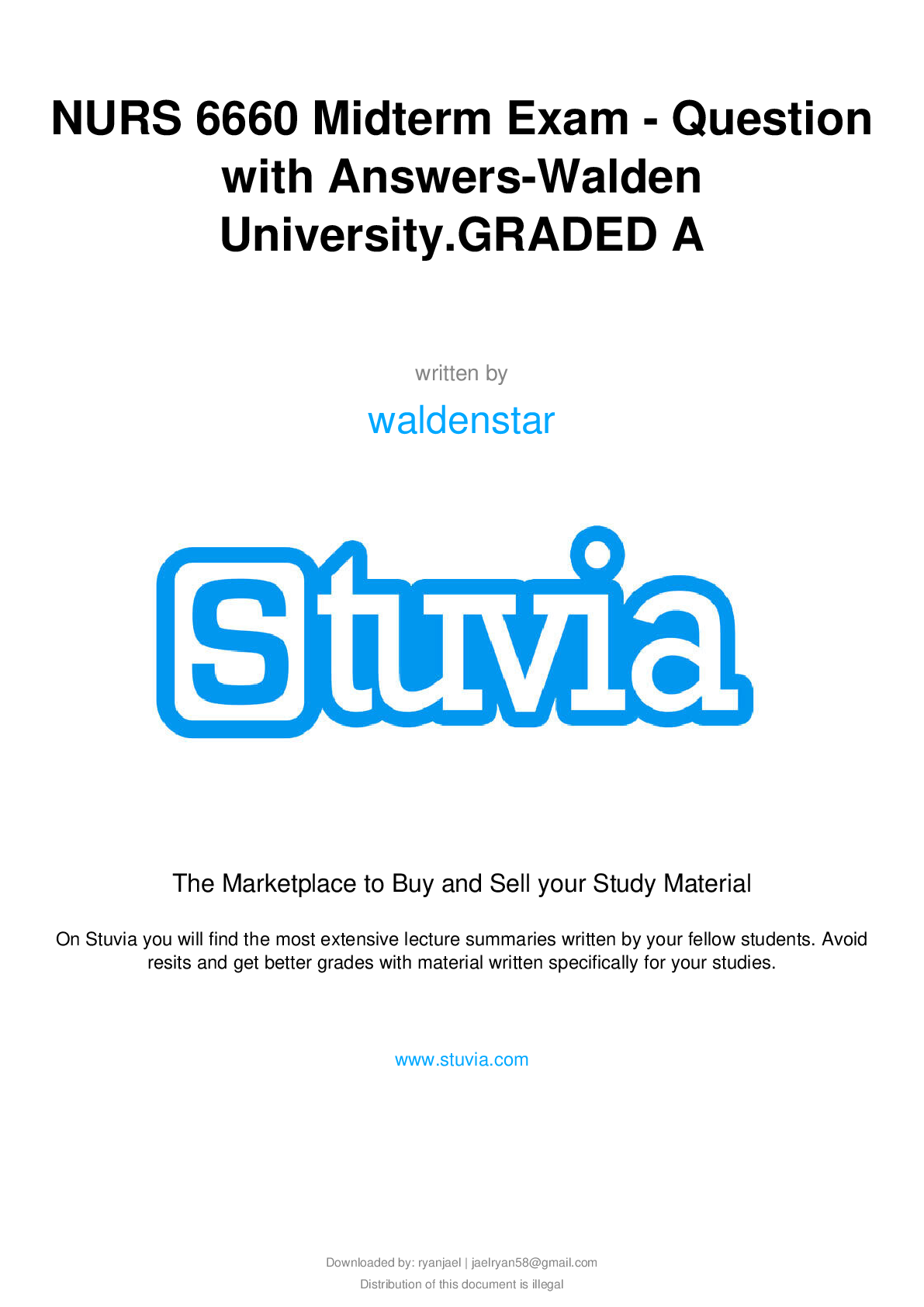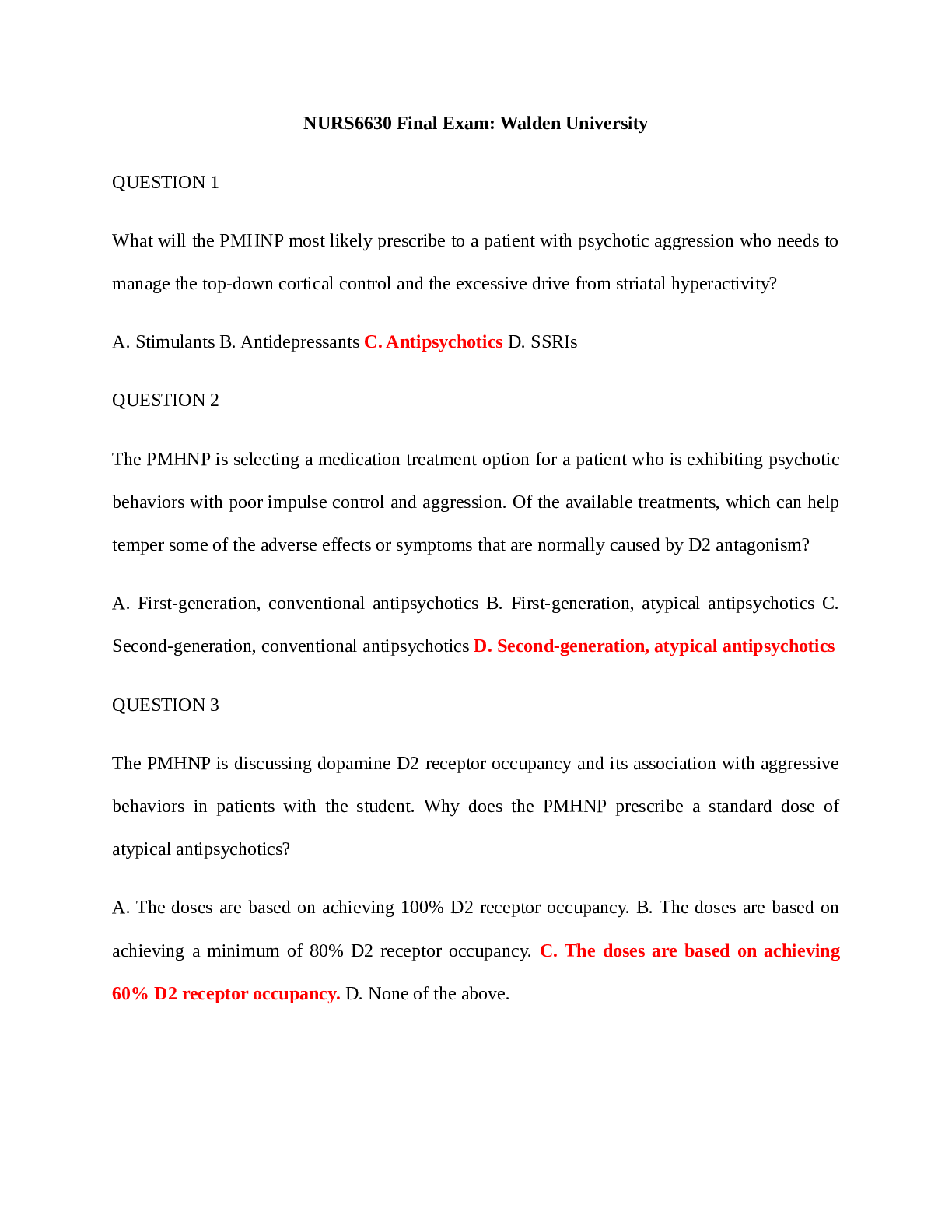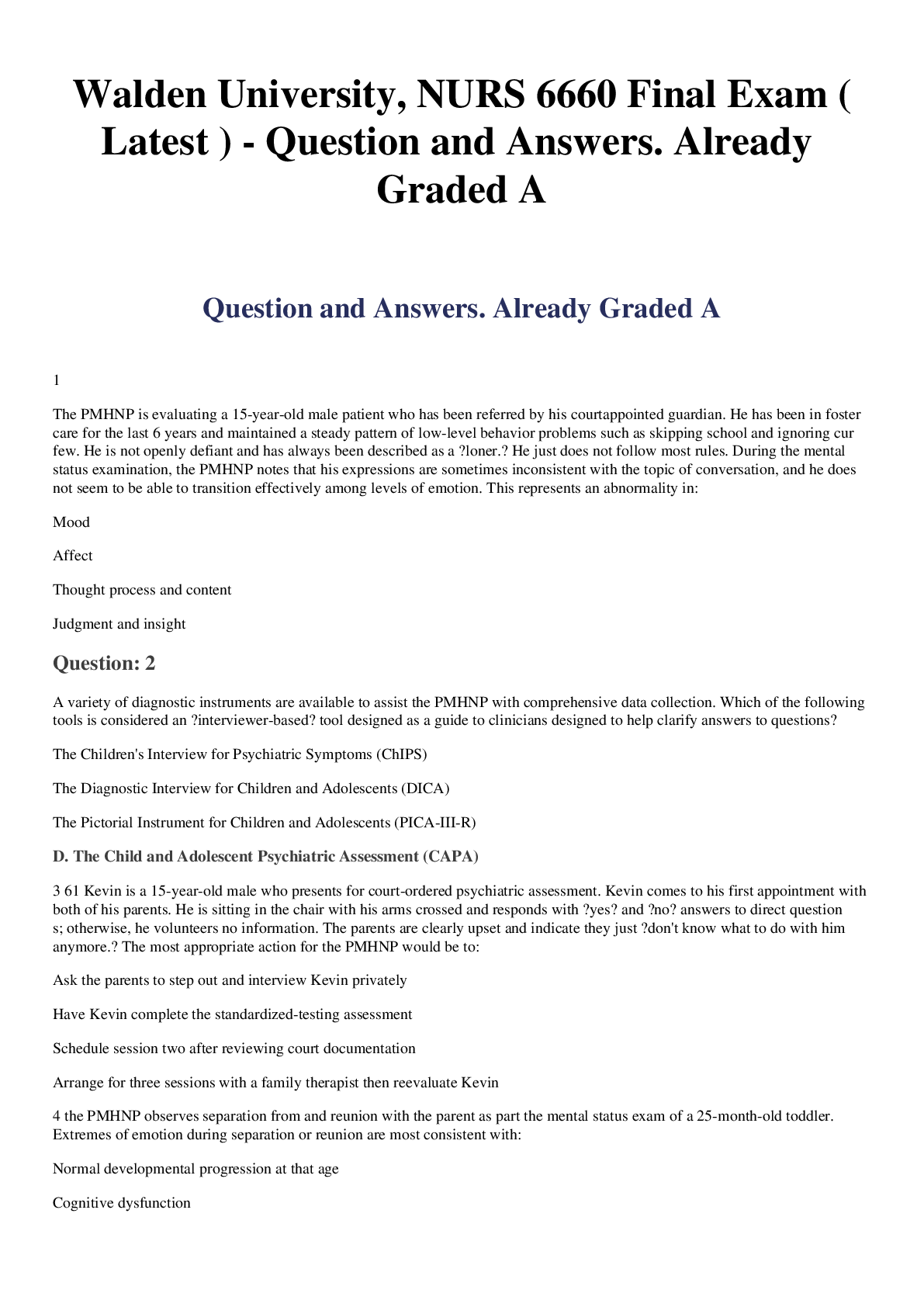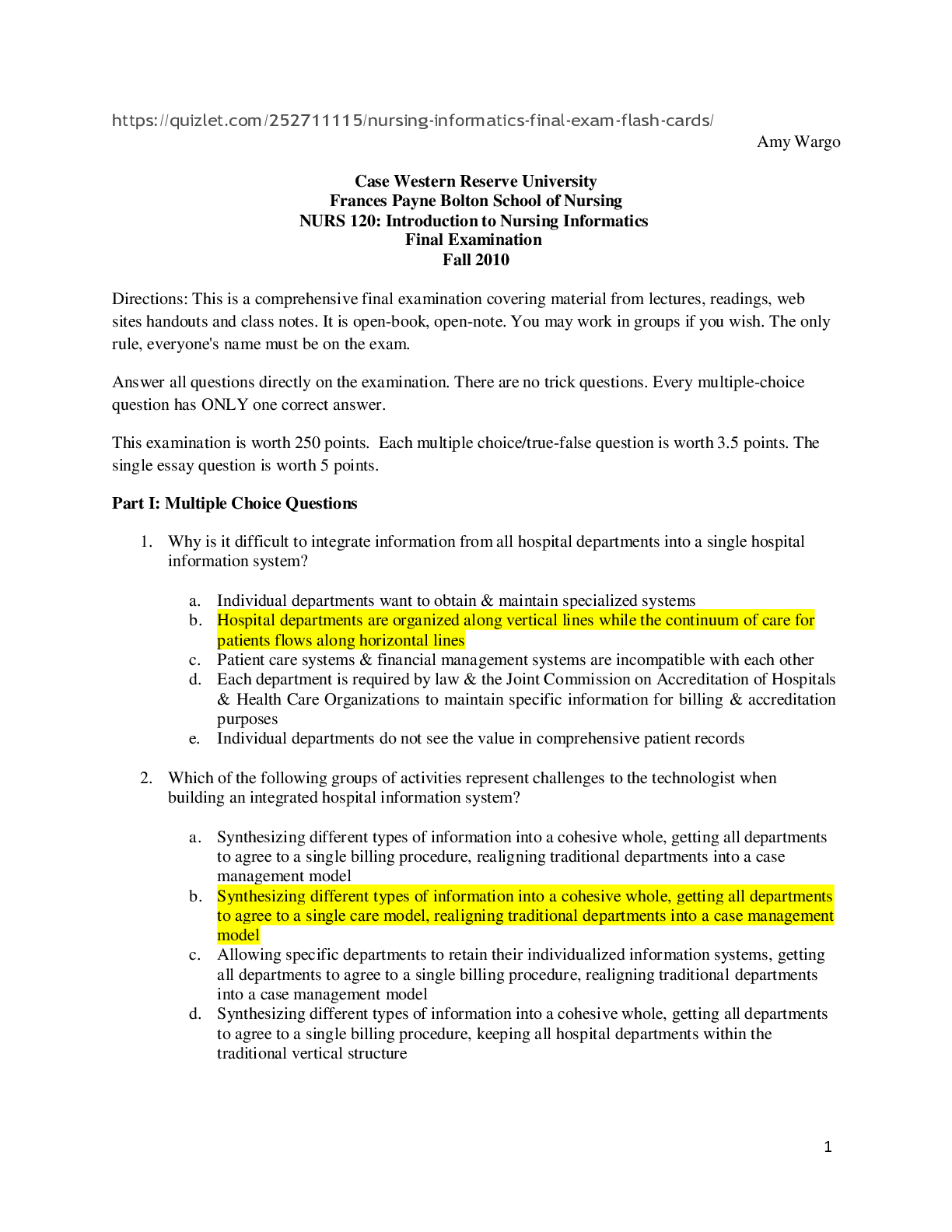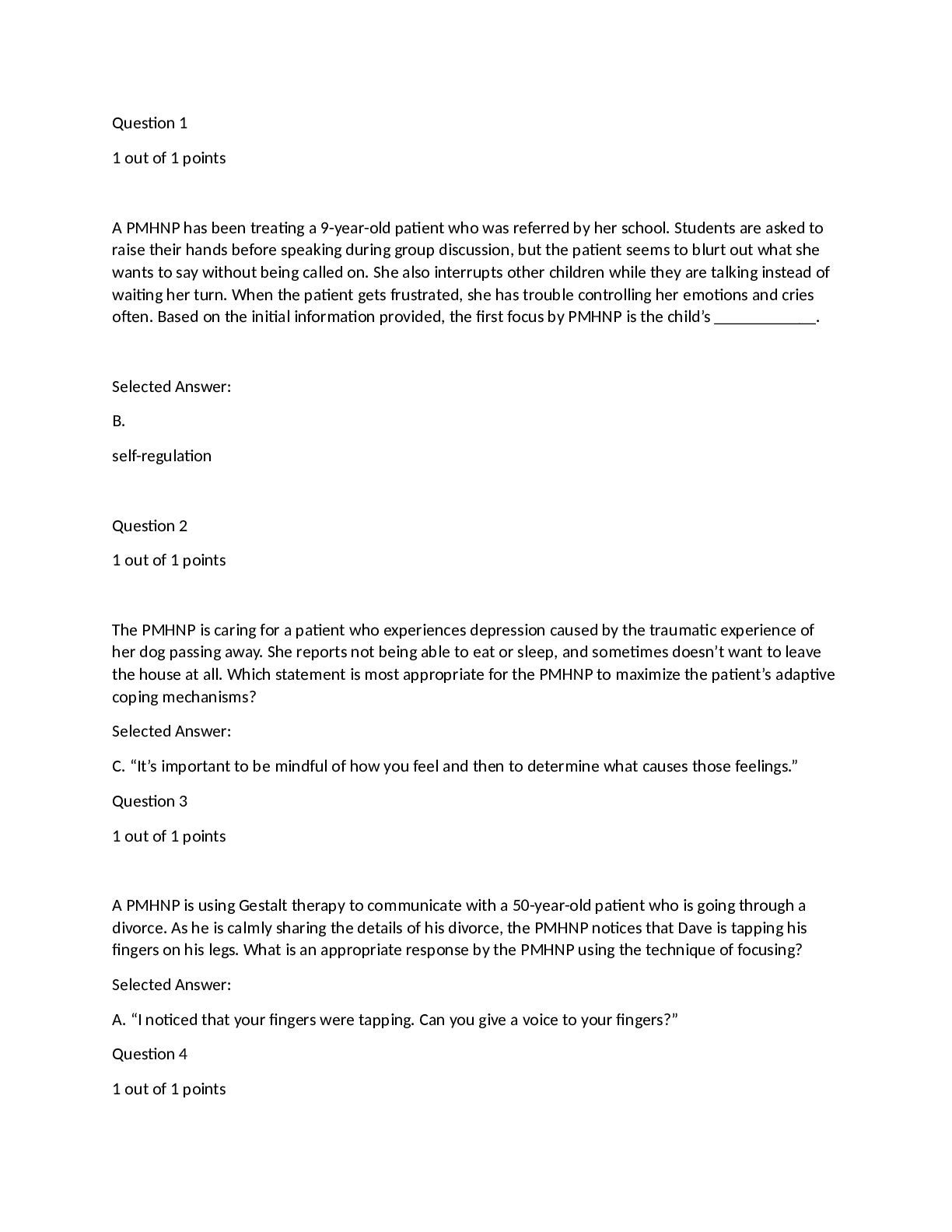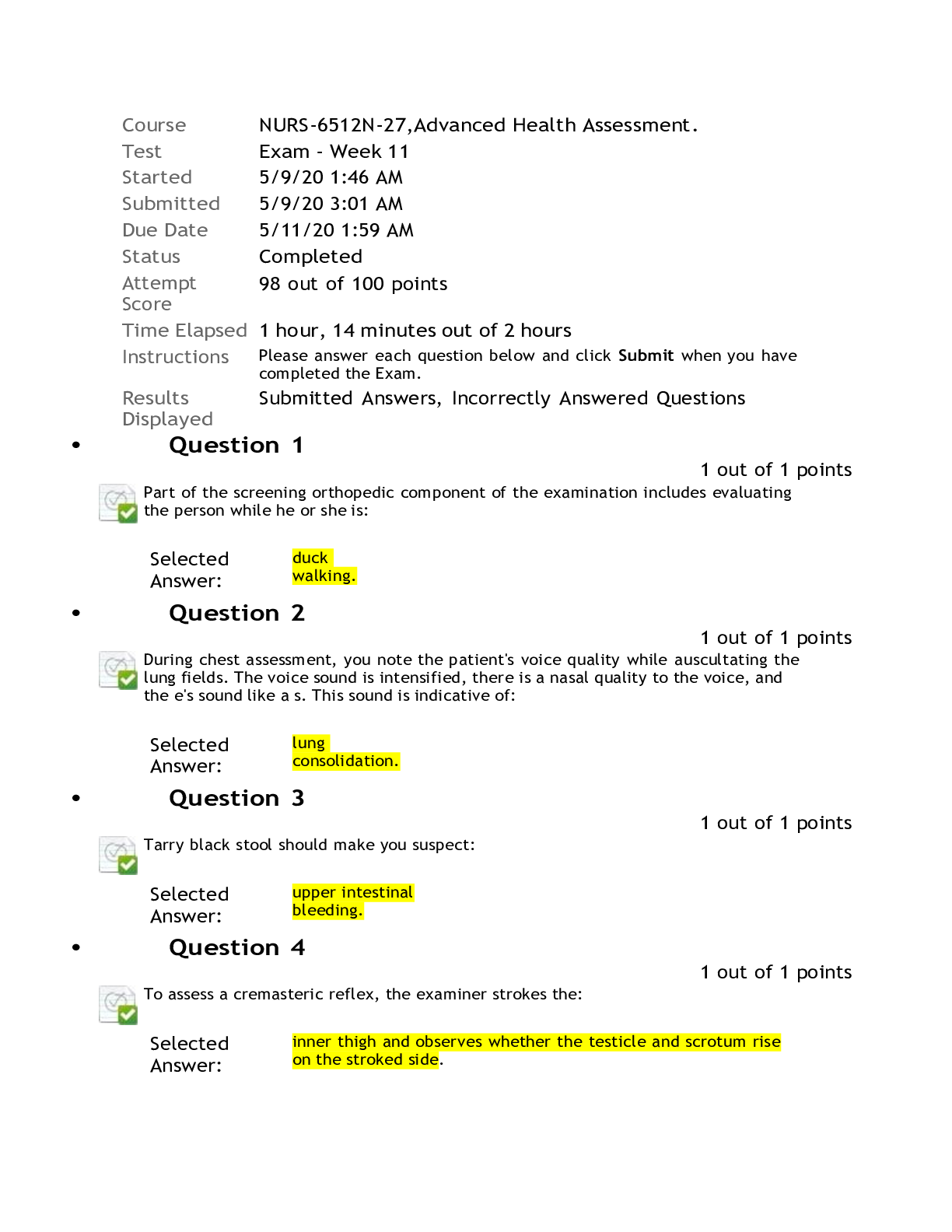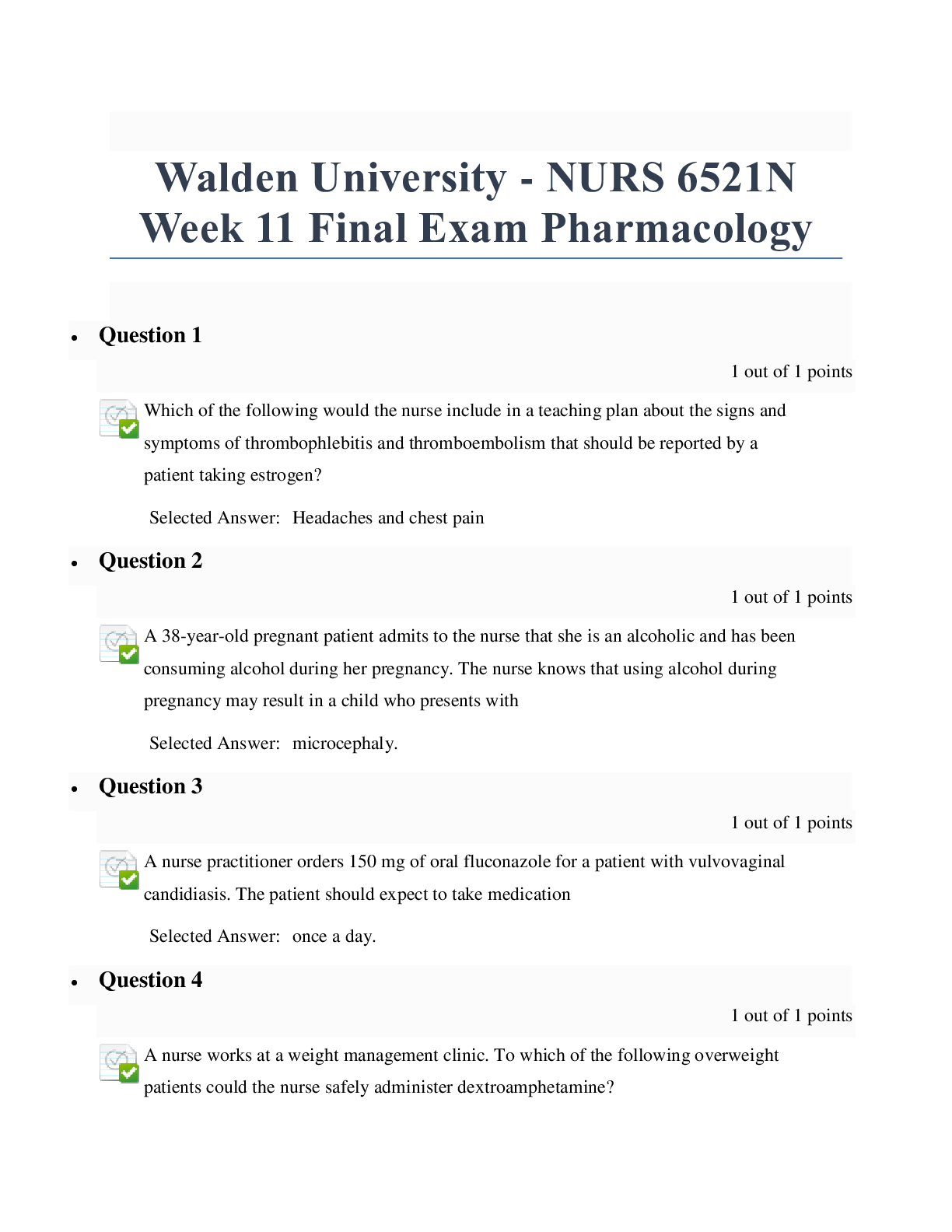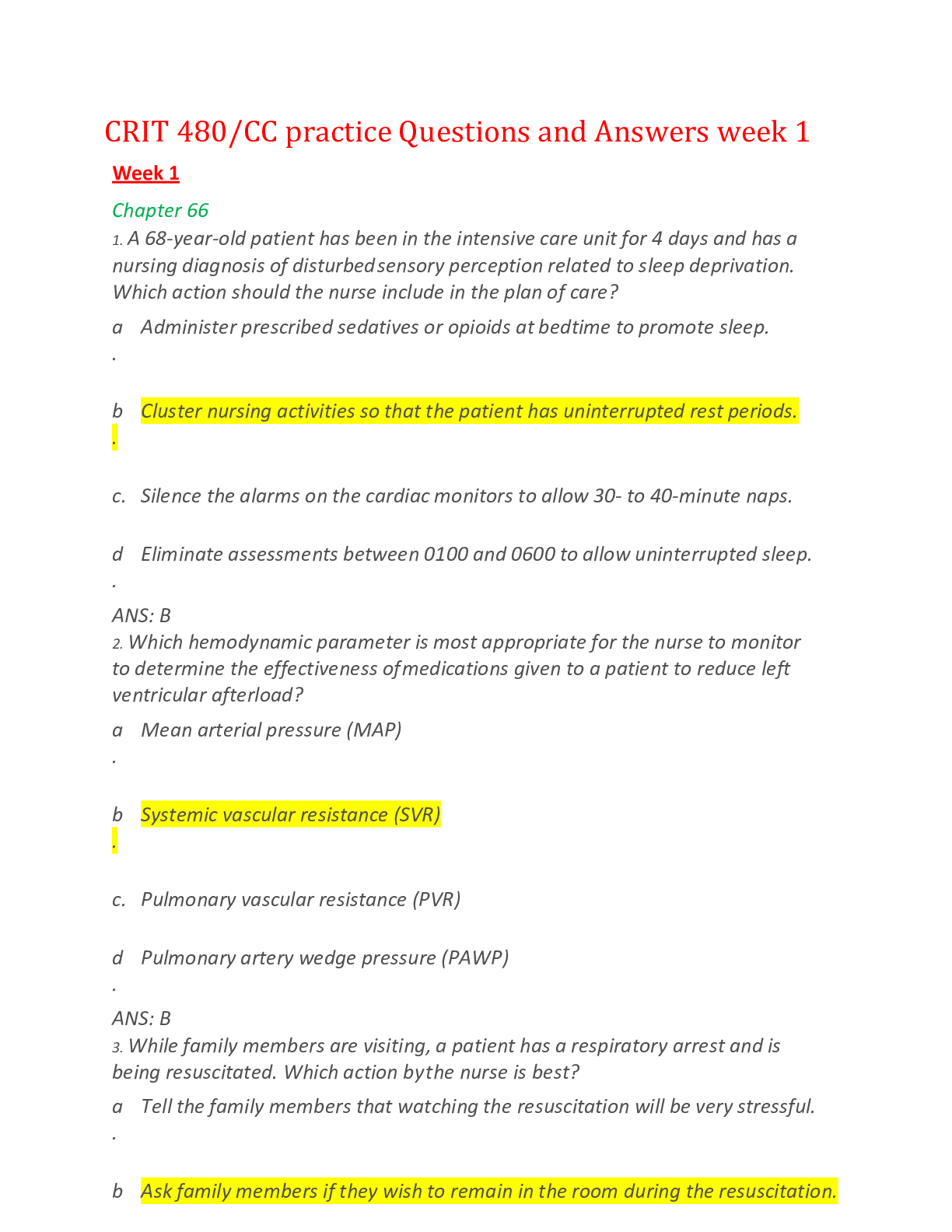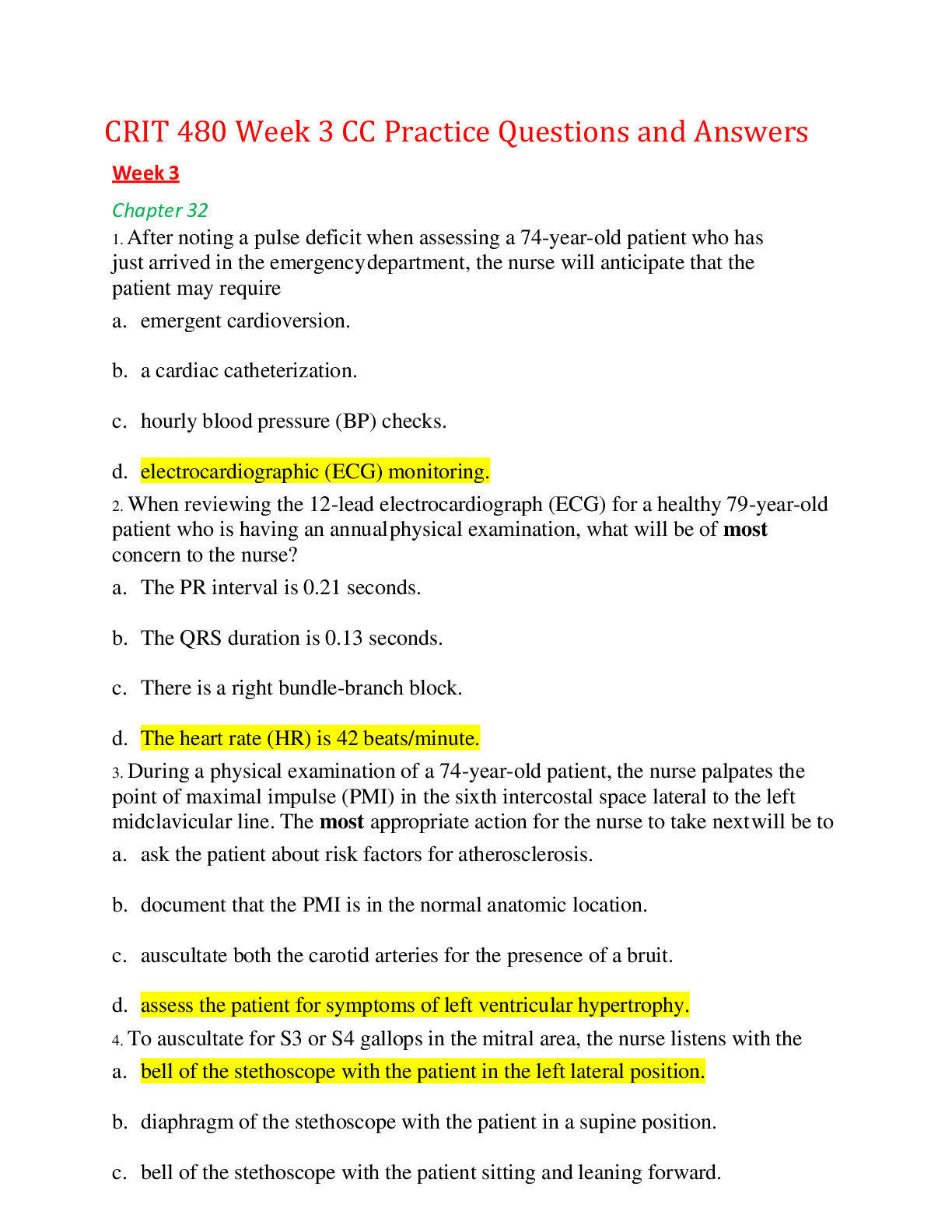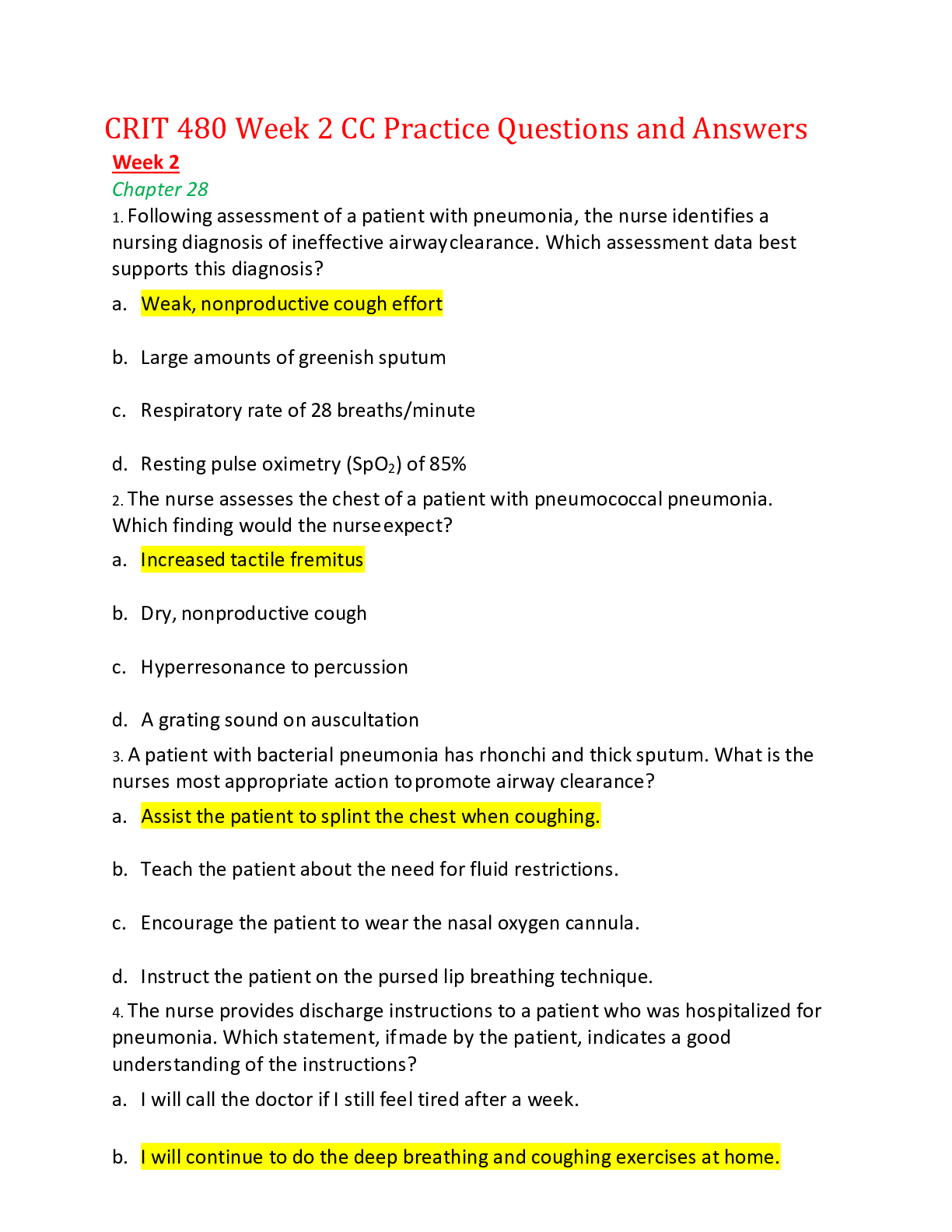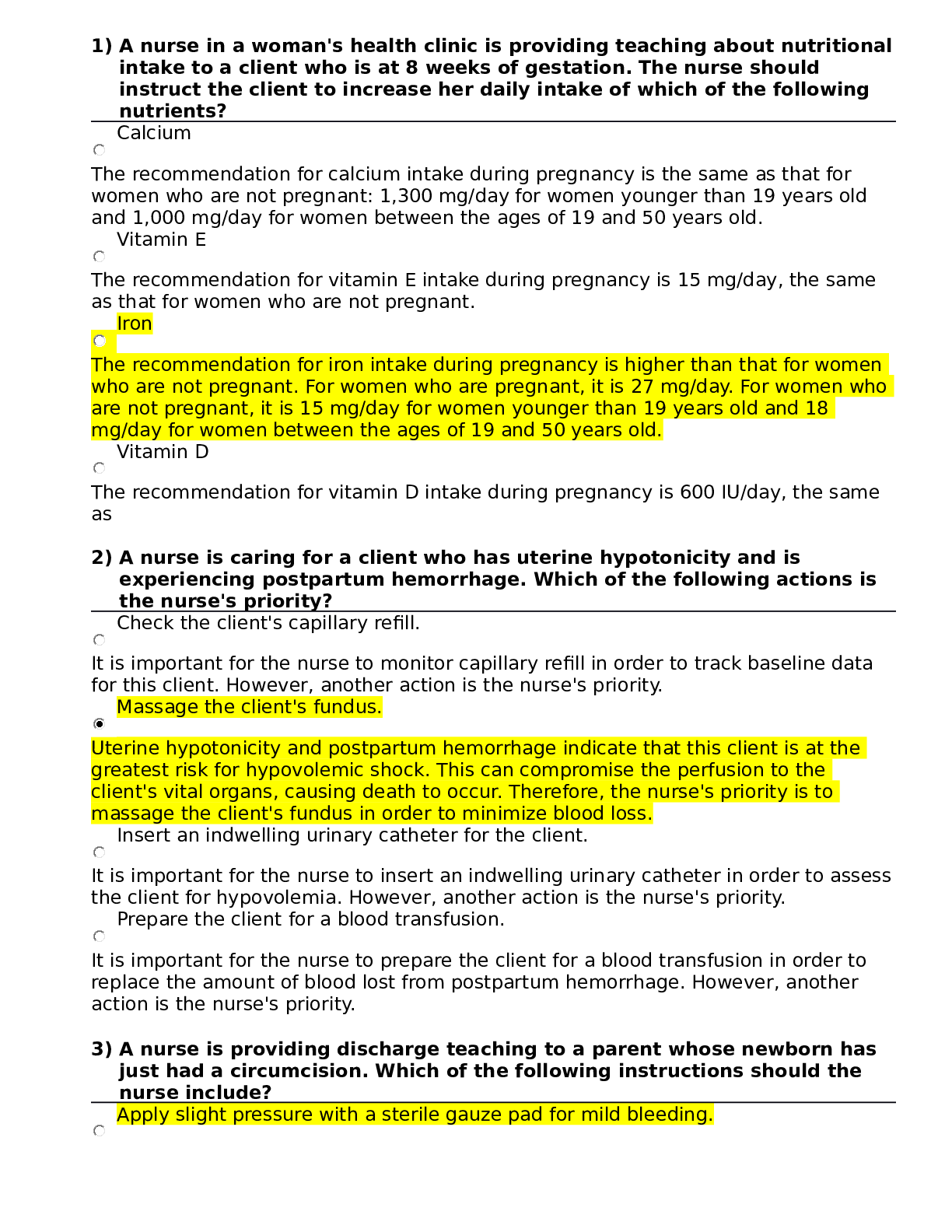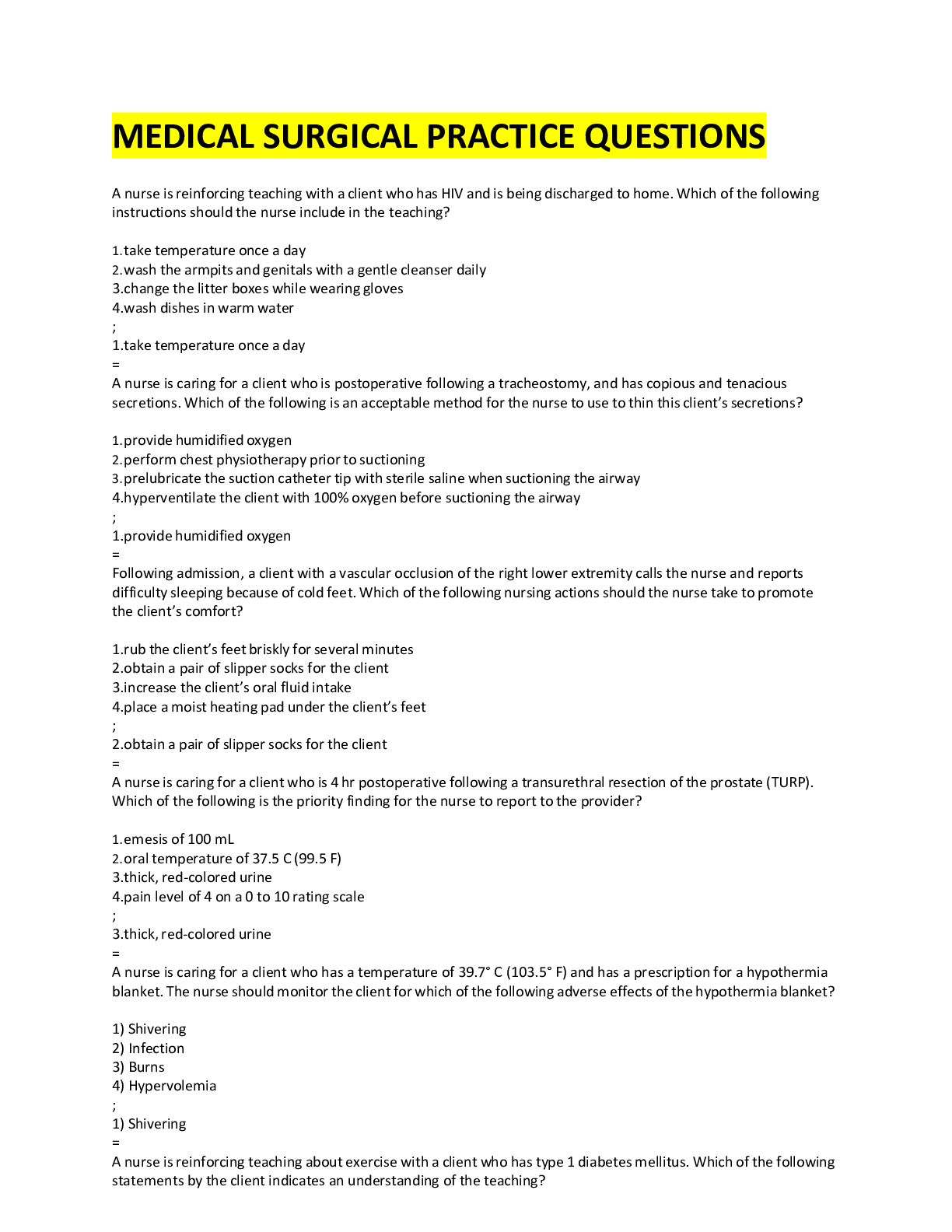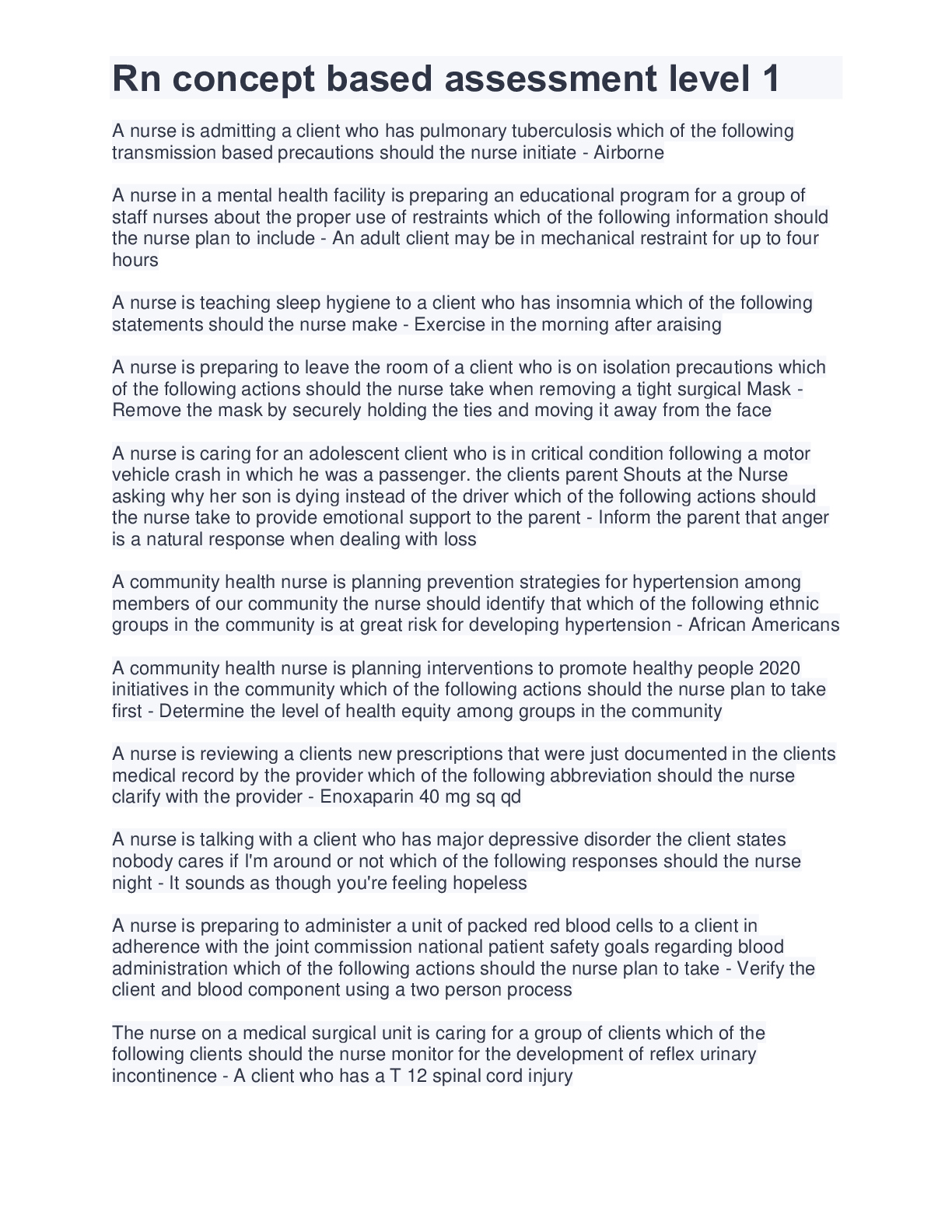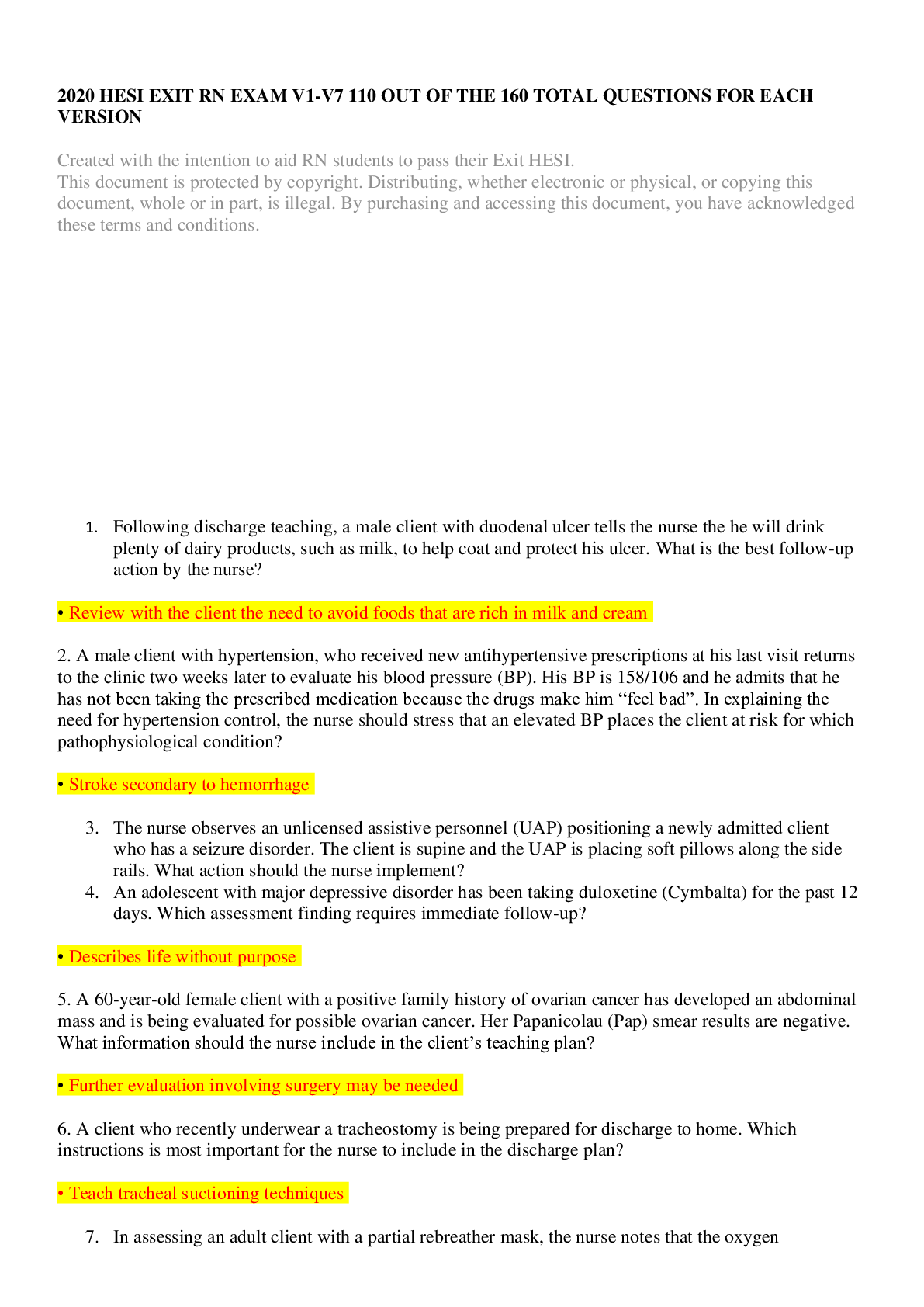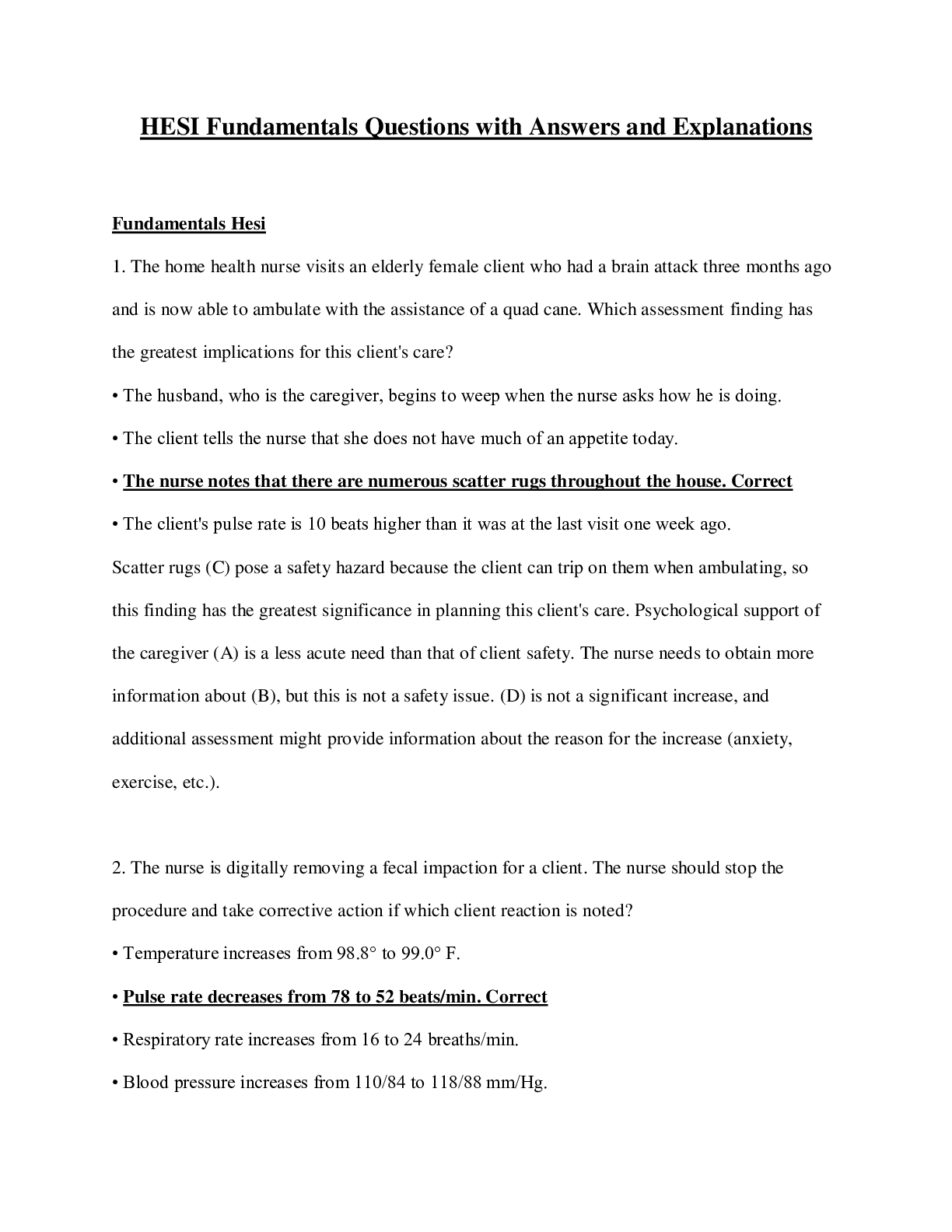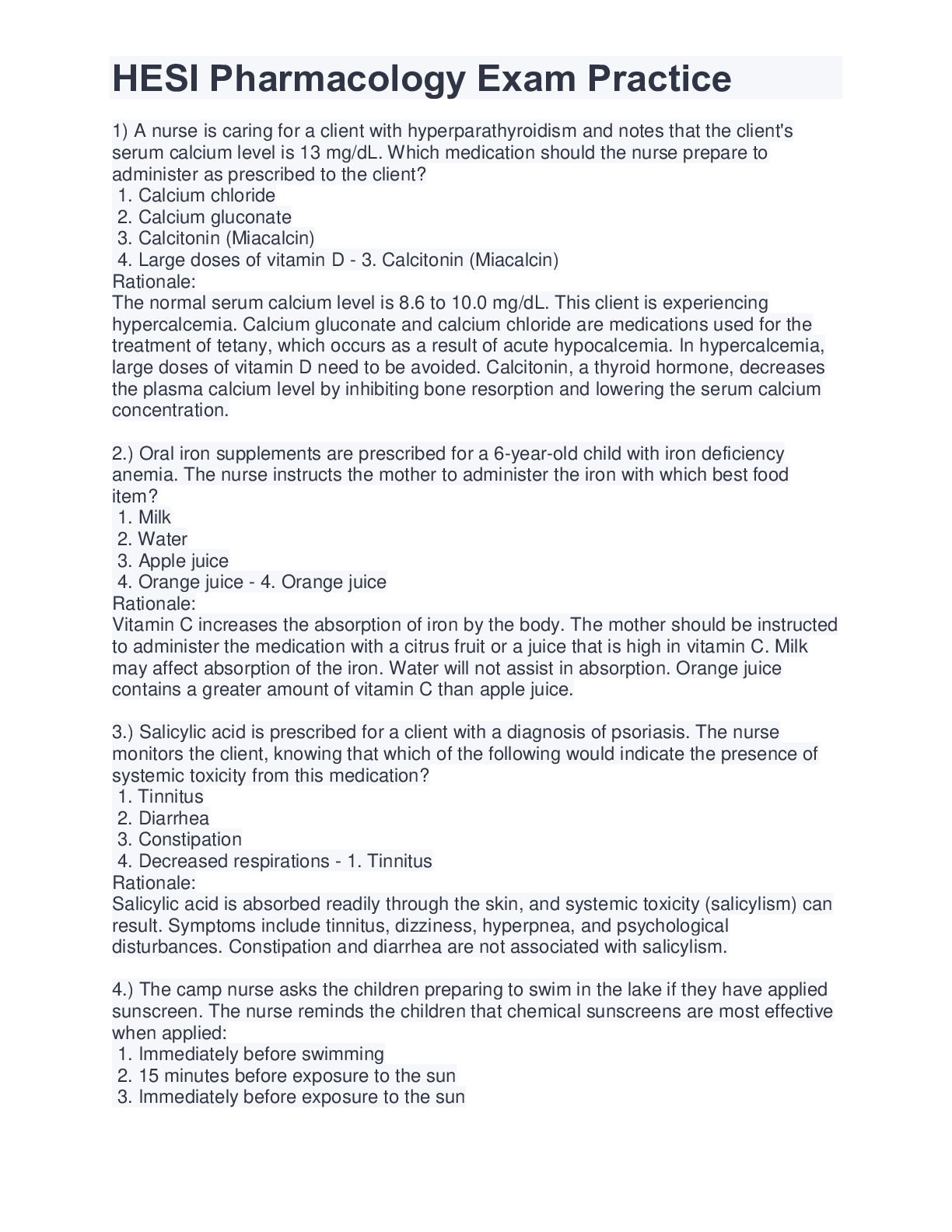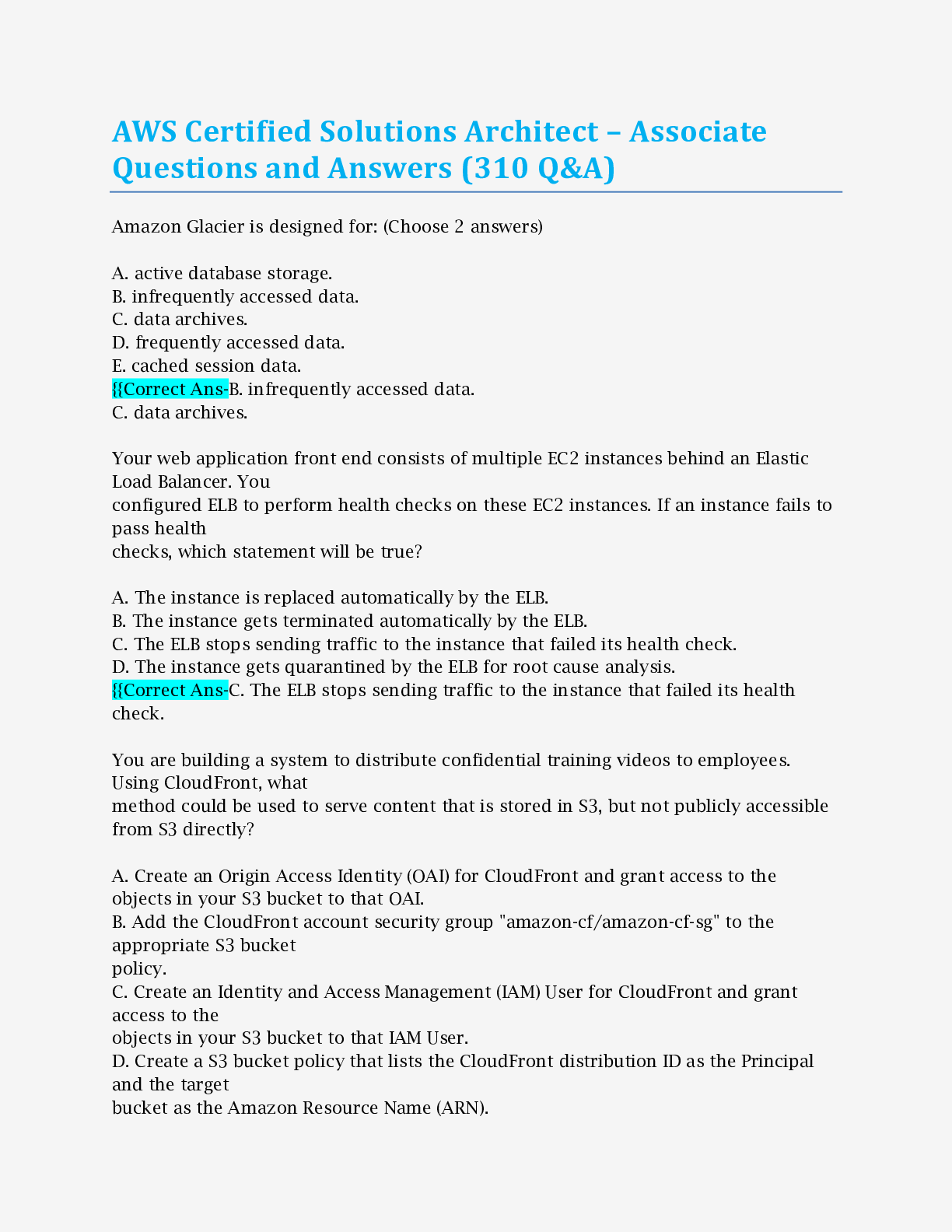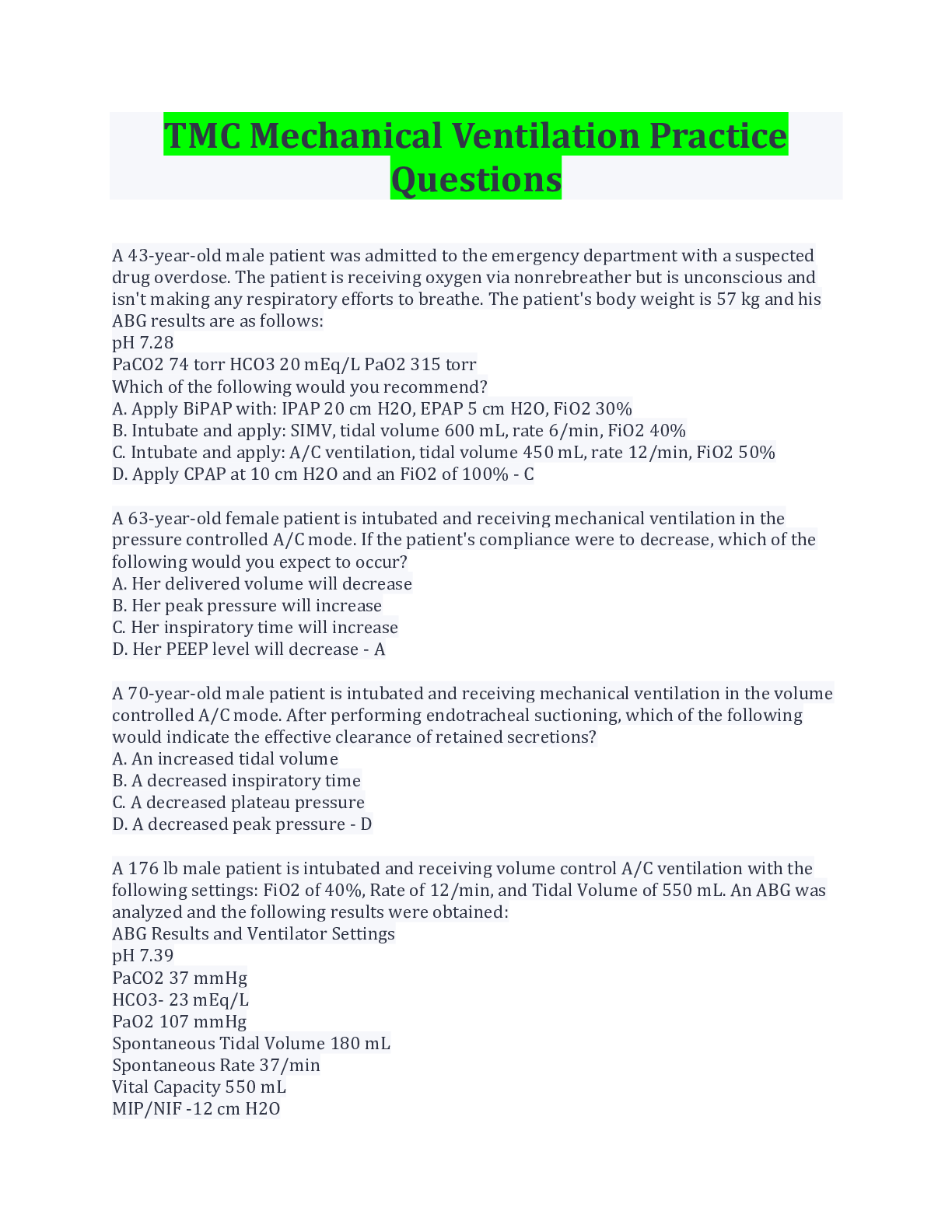MICRO_EXAM 2 PRACTICE QUESTIONS and ANSWERS-ECO 2023 LATEST AND SCORED A
Document Content and Description Below
MICRO_EXAM 2 PRACTICE QUESTIONS and ANSWERS-ECO 2023 ECO 2023 Principles of Microeconomics PRACTICE QUESTIONS for EXAM 2 1. Economies of scale occur when a. long-run average total costs rise as output... increases. b. long-run average total costs fall as output increases. c. average fixed costs are falling. d. average fixed costs are constant. 2. Diseconomies of scale occur when a. average fixed costs are falling. b. average fixed costs are constant. c. long-run average total costs rise as output increases. d. long-run average total costs fall as output increases. 3. Constant returns to scale occur when a. long-run total costs are constant as output increases. b. long-run average total costs are constant as output increases. c. the firm's long-run average cost curve is falling as output increases. d. the firm's long-run average cost curve is rising as output increases. 4. Specialization among workers occurs when a. quality management allows workers to switch from one task to another. b. each worker is allowed to perfect one particular task. c. each worker is responsible for a number of different tasks. d. All of the above are correct. 5. If a firm wants to capitalize on economies of scale, it may be able to do so by a. assigning limited tasks to their employees, so they can master those tasks. b. employing a smaller number of workers. c. producing a smaller quantity of output. d. All of the above are correct. 6. In reference to setting the production level, a firm’s cost curves a. by themselves do not tell us what decisions the firm will make. b. dictate what decisions the firm will make. c. have no bearing on what decisions the firm will make. d. None of the above are correct. 7. Economies of scale arise when a. an economy is self-sufficient in production. b. individuals in a society are self-sufficient. c. fixed costs are large relative to variable costs. d. workers are able to specialize in a particular task. 8. How long does it take a firm to go from the short run to the long run? a. six months b. one year c. two years d. It depends on the nature of the firm. 9. In the long run, a firm that produces and sells computers gets to choose a. how many workers to hire. b. the size of its factories. c. which short-run average-total-cost curve to use. d. All of the above are correct. 10. Total revenue equals a. total output multiplied by price per unit of output. b. total output divided by profit. c. (total output multiplied by sales price) – inventory surplus. d. (total output multiplied by sales price) – inventory shortage. Zach took $500,000 out of the bank and used it to start his new cookie business. The bank account pays 4 percent interest per year. During the first year of his business, Zach sold 12,000 boxes of cookies for $3 per box. Also, during the first year, the cookie business incurred costs that required outlays of money amounting to $14,000. 11. Zach’s accounting profit for the year was a. $–478,000. b. $–56,000. c. $2,000. d. $22,000. 12. Zach’s economic profit for the year was a. $–478,000. b. $–56,000. c. $2,000. d. $22,000. 13. Profit is defined as a. net revenue minus depreciation. b. total revenue minus total cost. c. average revenue minus average total cost. d. marginal revenue minus marginal cost. 14. Economists normally assume that the goal of a firm is to (i) sell as much of their product as possible. (ii) set the price of their product as high as possible. (iii) maximize profit. a. (i) and (ii) b. (ii) and (iii) c. (iii) only d. All of the above are correct.15. XYZ corporation produced 300 units of output but sold only 275 of the units it produced. The average cost of production for each unit of output produced was $100. Each of the 275 units sold was sold for a price of $95. Total revenue for the XYZ corporation would be a. –$3,875. b. $26,125. c. $28,500. d. $30,000. 16. The amount of money that a wheat farmer could have earned if he had planted barley instead of wheat is a. an explicit cost. b. an accounting cost c. an implicit cost. d. forgone accounting profit. 17. Economic profit a. will never exceed accounting profit. b. is most often equal to accounting profit. c. is always at least as large as accounting profit. d. is a less complete measure of profitability than accounting profit. 18. Accounting profit is equal to (i) total revenue – implicit costs. (ii) total revenue – opportunity costs. (iii) economic profit implicit costs. a. (i) only b. (iii) only c. (i) and (ii) d. None of the above are correct. 19. Dolores used to work as a high school teacher for $40,000 per year but quit in order to start her own catering business. To buy the necessary equipment, she withdrew $20,000 from her savings, (which paid 3 percent interest) and borrowed $30,000 from her uncle, whom she pays 3 percent interest per year. Last year she paid $25,000 for ingredients and had revenue of $60,000. She asked Louis the accountant and Greg the economist to calculate her profit for her. a. Louis says her profit is $34,100 and Greg says her profit is $6,500. b. Louis says her profit is $34,100 and Greg says she lost $6,500. c. Louis says her profit is $35,000 and Greg says she lost $5,000. d. Louis says her profit is $33,500 and Greg says her profit is 33,500. 20. A production function is a relationship between a. inputs and quantity of output. b. inputs and revenue. c. inputs and costs. d. inputs and profit. 21. The marginal product of labor is equal to the a. incremental cost associated with a one unit increase in labor. b. incremental profit associated with a one unit increase in labor. c. increase in labor necessary to generate a one unit increase in output. d. increase in output obtained from a one unit increase in labor. 22. The marginal product of labor can be defined as a. change in profit/change in labor. b. change in output/change in labor. c. change in labor/change in output. d. change in labor/change in total cost. 23. One would expect to observe diminishing marginal product of labor when a. crowded office space reduces the productivity of new workers. b. workers are discouraged about the lack of help from other workers. c. only new workers are trained in using the most productive capital. d. union workers are told to reduce their work effort in preparation for a new round of collective bargaining talks. 24. When adding another unit of labor leads to an increase in output that is smaller than increases in output that resulted from adding previous units of labor, we have the property of a. diminishing labor. b. diminishing output. c. diminishing marginal product. d. negative marginal product. The figure below depicts a production function for a firm that produces cookies. Use the figure to answer questions 26 and 26. 25. As the number of workers increases, a. total output increases, but at a decreasing rate. b. marginal product increases, but at a decreasing rate. c. marginal product increases at an increasing rate. d. total output decreases. ANSWER: a. total output increases, but at a decreasing rate. 26. With regard to cookie production, the figure implies a. diminishing marginal product of workers. b. diminishing marginal cost of cookie production. c. decreasing cost of cookie production. d. increasing marginal product of workers. 27. Which of the following statements about a production function is correct for a firm that uses labor to produce output? a. The production function depicts the relationship between the quantity of labor and the quantity of output. b. The slope of the production function measures marginal cost. c. The quantity of output is measured along the horizontal axis. d. All of the above are correct. quantity of output. 28. Average total cost equals a. change in total costs divided by quantity produced. b. change in total costs divided by change in quantity produced. c. (fixed costs variable costs) divided by quantity produced. d. (fixed costs variable costs) divided by change in quantity produced. 29. Variable cost divided by quantity produced is a. average total cost. b. marginal cost. c. profit. d. None of the above are correct. 30. Marginal cost equals (i) change in total cost divided by change in quantity produced. (ii) change in variable cost divided by change in quantity produced. (iii) the average fixed cost of the current unit. a. (i) and (ii) b. (ii) and (iii) c. (ii) only d. All of the above are correct. 31. Marginal cost tells us the a. value of all resources used in a production process. b. marginal increment to profitability when price is constant. c. amount by which total cost rises when output is increased by one unit. d. amount by which output rises when labor is increased by one unit. The figure below depicts a total cost function for a firm that produces cookies. Use the figure to answer questions 32 through 33. 32. Which of the following is true of the production function (not pictured) that underlies this total cost function? (ii) Total output increases as the quantity of inputs increases, but at a decreasing rate. (ii) Marginal product is diminishing for all levels of input usage. (iii) The slope of the production function decreases as the quantity of inputs increases. a. (i) only b. (ii) and (iii) c. (i) and (iii) d. All of the above are correct. 33. The changing slope of the total cost curve reflects a. decreasing average variable cost. b. decreasing average total cost. c. decreasing marginal product. d. increasing fixed cost. 34. Which of the following statements best captures the nature of the underlying production function? a. Output increases at a decreasing rate with additional units of input. b. Output increases at an increasing rate with additional units of input. c. Output decreases at a decreasing rate with additional units of input. d. Output decreases at an increasing rate with additional units of input. Refer to the figures below to answer Questions 35 through 37. Figure 4 35. Which of the figures represents the total cost curve for a firm? a. Figure 1 b. Figure 2 c. Figure 3 d. Figure 4 36. Which of the figures represents the marginal cost curve for a firm? a. Figure 1 b. Figure 2 c. Figure 3 d. Figure 4 37. Which of the figures represents the production function for a firm? a. Figure 1 b. Figure 2 c. Figure 3 d. Figure 4 The curves below reflect information about the cost structure of a firm. Use the figure to answer questions 38 through 44. 38. Which of the curves is most likely to represent average total cost? a. A b. B c. C d. D 39. Which of the curves is most likely to represent average fixed cost? a. A b. B c. C d. D 40. Which of the curves is most likely to represent average variable cost? a. A b. B c. C d. D 41. Which of the curves is most likely to represent marginal cost? a. A b. B c. C 42. This particular firm is necessarily experiencing increasing marginal product when curve a. A is falling. b. B is falling. c. C is falling. d. D is falling. 43. This particular firm is necessarily experiencing diminishing marginal product when curve (i) A is rising. (ii) B is rising. (iii) C is rising. a. (i) only b. (iii) only c. (i) and (ii) d. All of the above are correct. 44. Curve A is U-shaped because of a. diminishing marginal product. b. increasing marginal product. c. the fact that increasing marginal product follows decreasing marginal product. d. the fact that decreasing marginal product follows increasing marginal product. 45. When a firm in a competitive market receives $500 in total revenue, it has a marginal revenue of $10. What is the average revenue, and how many units were sold? a. $5 and 100 b. $10 and 50 c. $10 and 100 d. The answer cannot be determined from the information given. 46. Starting from a situation in which a firm in a competitive market produces and sells 500 door knobs for a price of $10 per doorknob, which of the following events would decrease the firm’s average revenue? a. The firm increases its output above 500 doorknobs. b. The firm decreases its output below 500 doorknobs. c. The market price of doorknobs rises above $10. d. The market price of doorknobs falls below $10. 47. Whenever a perfectly competitive firm chooses to change its level of output, holding the price of the product constant, its marginal revenue a. increases if MR < ATC and decreases if MR > ATC. b. does not change. c. increases. d. decreases. 48. If a firm in a competitive market reduces its output by 20 percent, then as a result the price of its output is likely to a. increase. b. remain unchanged. c. decrease by less than 20 percent. d. decrease by more than 20 percent. a. Total revenue = Average revenue. b. Total revenue = Marginal revenue. c. Total cost = Marginal revenue. d. Average revenue = Marginal revenue. 50. A government-created monopoly arises when a. government spending in a certain industry gives rise to monopoly power. b. the government exercises its market control by encouraging competition among sellers. c. the government gives a firm the exclusive right to sell some good or service. d. All of the above could qualify as government-created monopolies. 51. For a competitive firm, a. average revenue equals the price of the good, but marginal revenue is different. b. marginal revenue equals the price of the good, but average revenue is different. c. average revenue equals marginal revenue, but the price of the good is different. d. average revenue, marginal revenue, and the price of the good are all equal to one another. 52. Which of the following statements is (are) true of a monopoly? (i) A monopoly has the ability to set the price of its product at whatever level it desires. (ii) A monopoly’s total revenue will always increase when it increases the price of its product. (iii) A monopoly can earn unlimited profits. a. (i) only b. (ii) only c. (i) and (ii) d. (ii) and (iii) 53. When a firm has a natural monopoly, the firm’s a. marginal cost always exceeds its average total cost. b. total cost curve is horizontal. c. average total cost curve is downward sloping. d. All of the above are correct. ANSWER: c. average total cost curve is downward sloping. Refer to the diagram below to answer questions 54 through 60. 54. To maximize total surplus, a benevolent social planner would choose which of the following outcomes? a. 100 units of output and a price of $10 per unit b. 150 units of output and a price of $10 per unit c. 150 units of output and a price of $15 per unit d. 200 units of output and a price of $10 per unit 55. To maximize its profit, a monopolist would choose which of the following outcomes? a. 100 units of output and a price of $10 per unit b. 100 units of output and a price of $20 per unit c. 150 units of output and a price of $15 per unit d. 200 units of output and a price of $20 per unit 56. The monopolist’s maximum profit a. is $800. b. is $1,000. c. is $1,250. d. cannot be determined from the diagram. 57. The deadweight loss caused by a profit-maximizing monopoly amounts to a. $150. b. $200. c. $250. d. $300. 58. To maximize total surplus, a benevolent social planner would choose which of the following outcomes? a. 100 units of output and a price of $10 per unit b. 150 units of output and a price of $10 per unit c. 150 units of output and a price of $15 per unit d. 200 units of output and a price of $10 per unit 59. The monopolist’s maximum profit a. is $800. b. is $1,000. c. is $1,250. d. cannot be determined from the diagram. 60. The deadweight loss caused by a profit-maximizing monopoly amounts to a. $150. b. $200. c. $250. d. $300. [Show More]
Last updated: 1 year ago
Preview 1 out of 13 pages
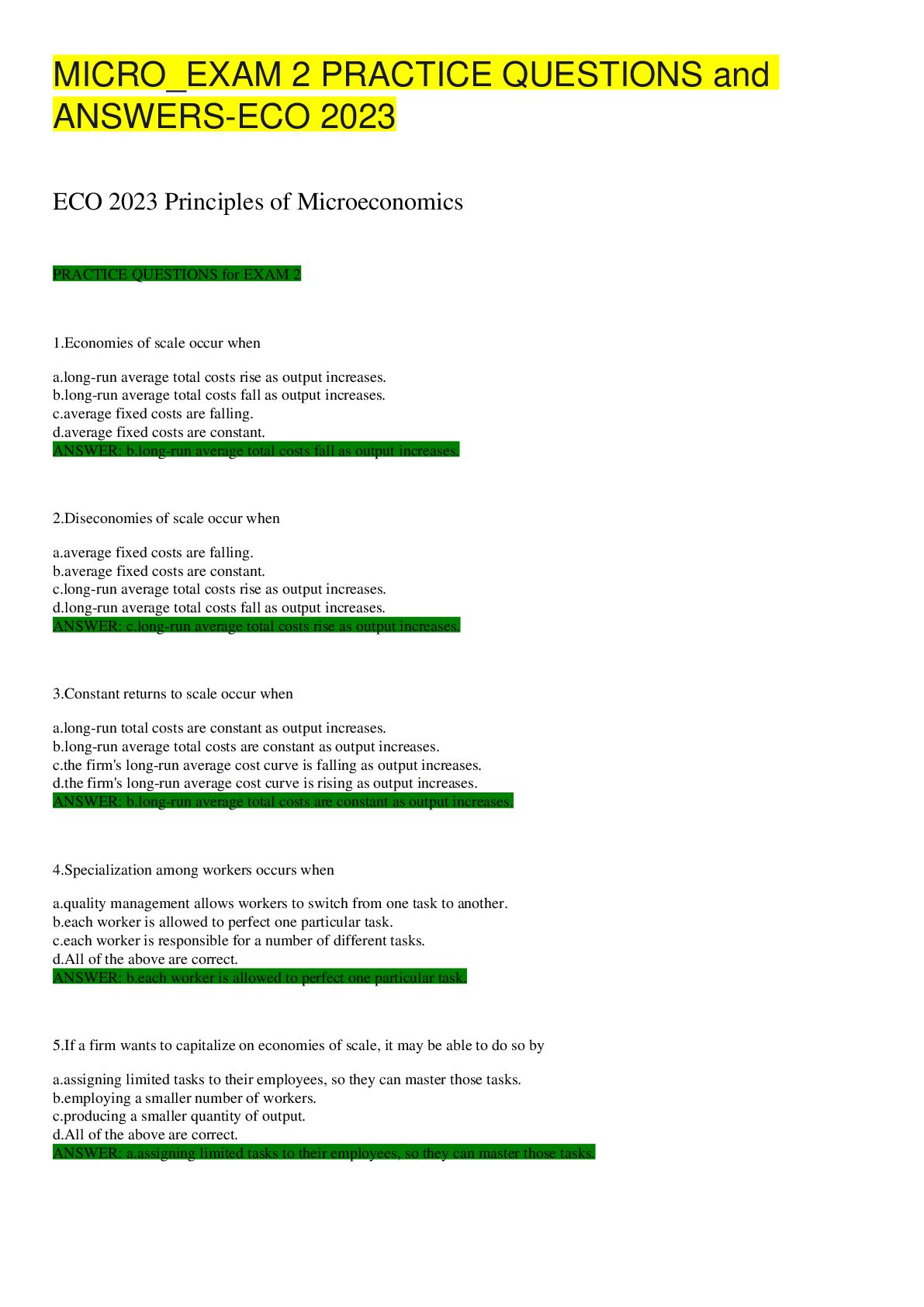
Reviews( 0 )
Document information
Connected school, study & course
About the document
Uploaded On
Jun 19, 2020
Number of pages
13
Written in
Additional information
This document has been written for:
Uploaded
Jun 19, 2020
Downloads
0
Views
62

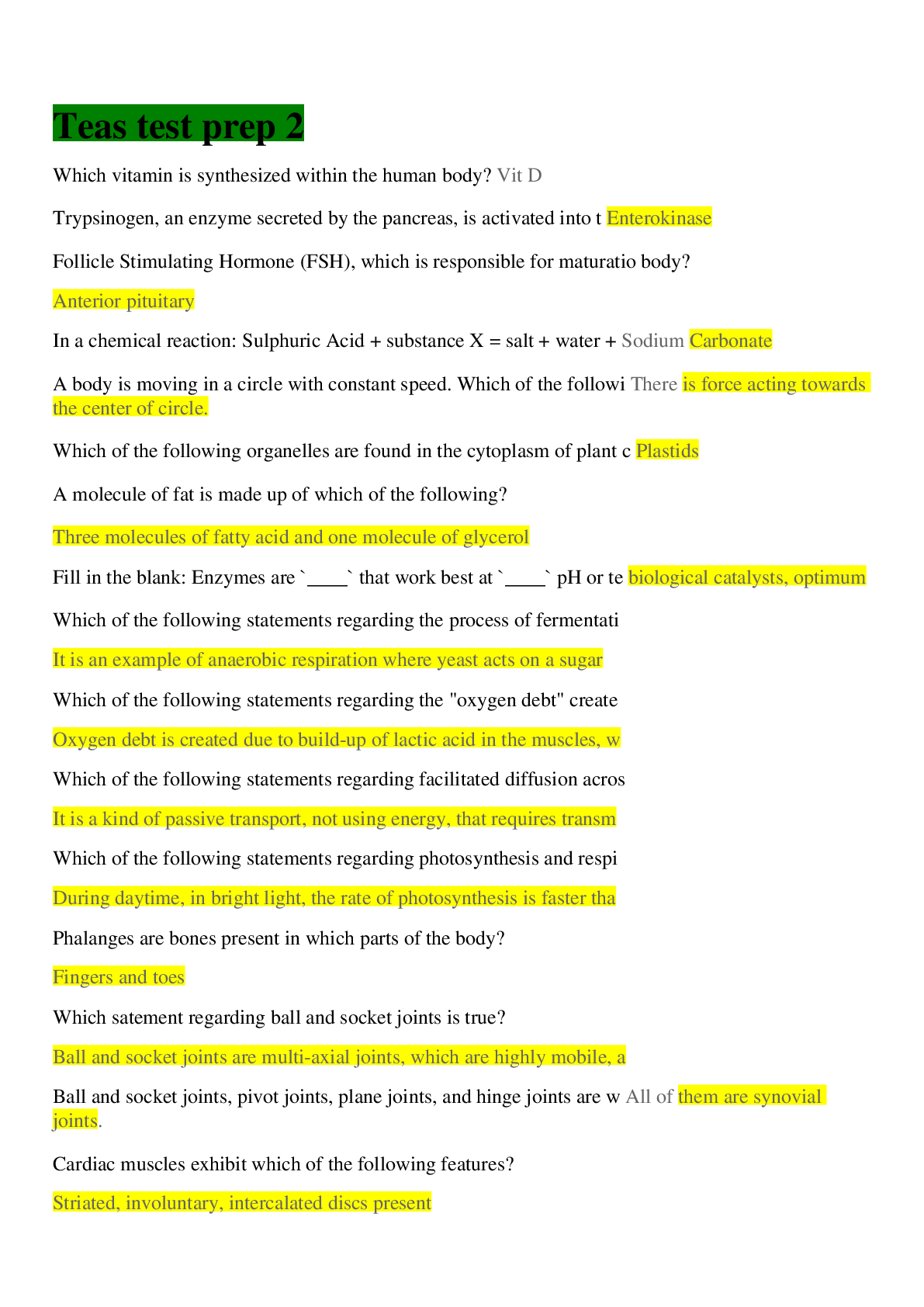
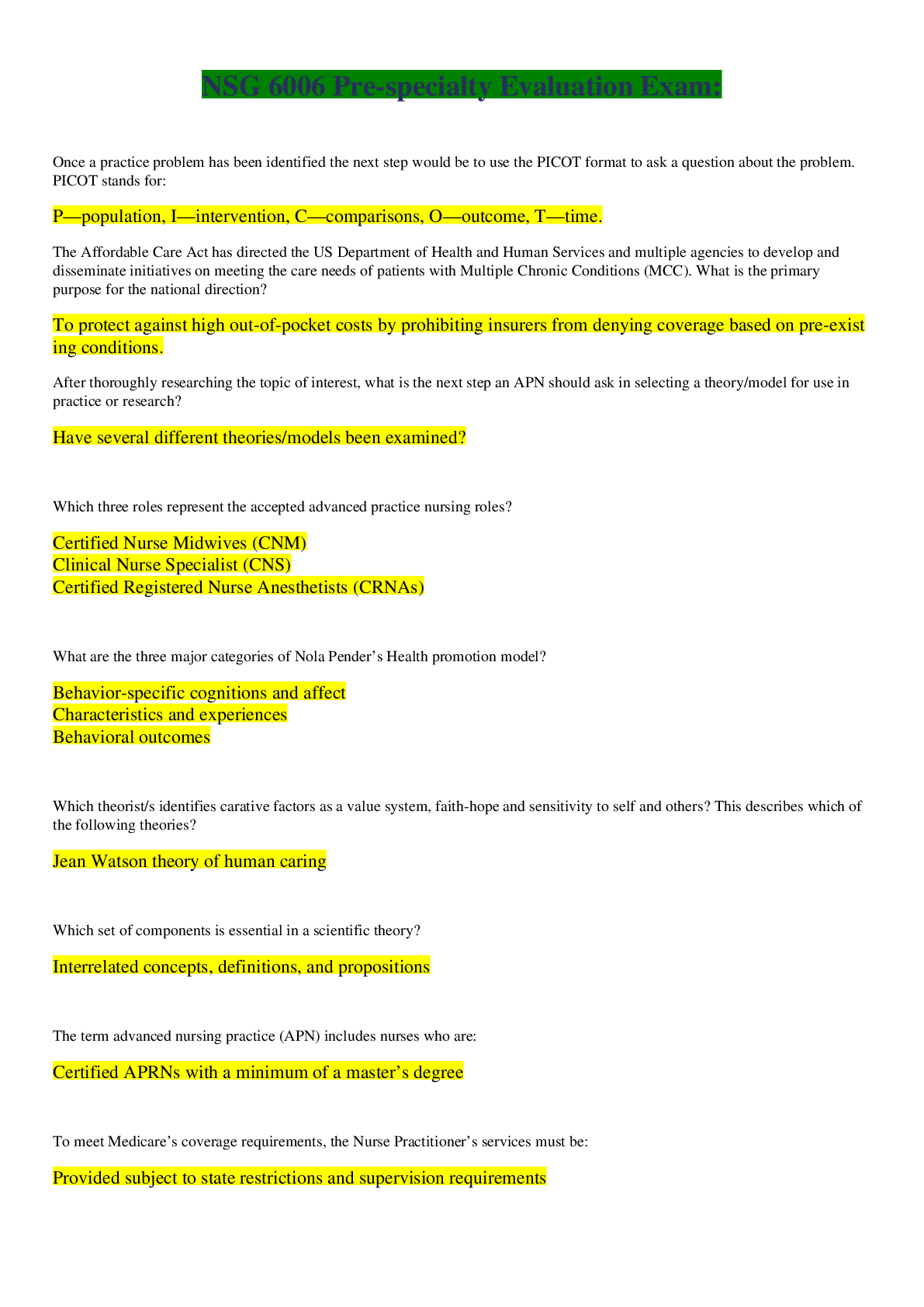

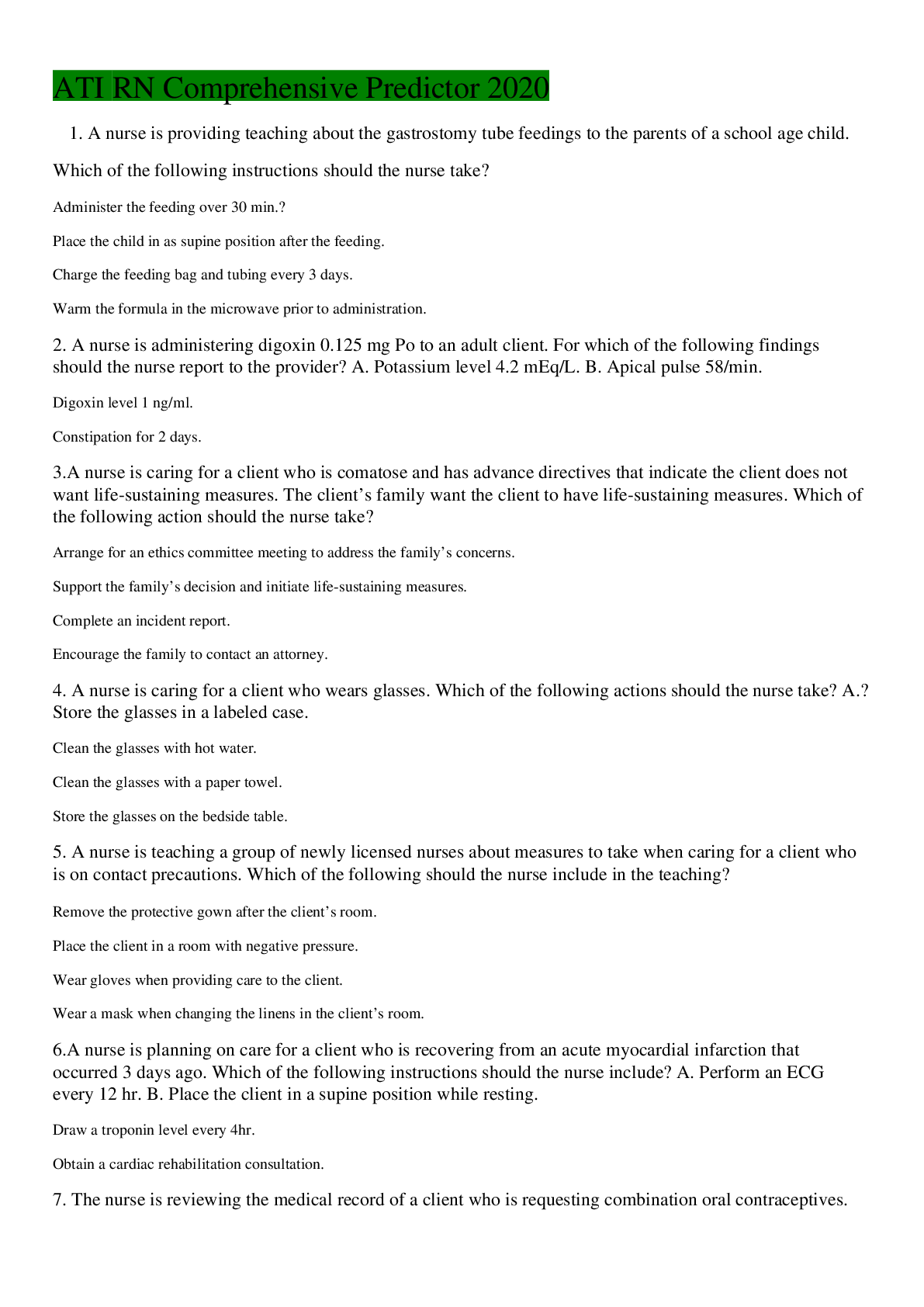
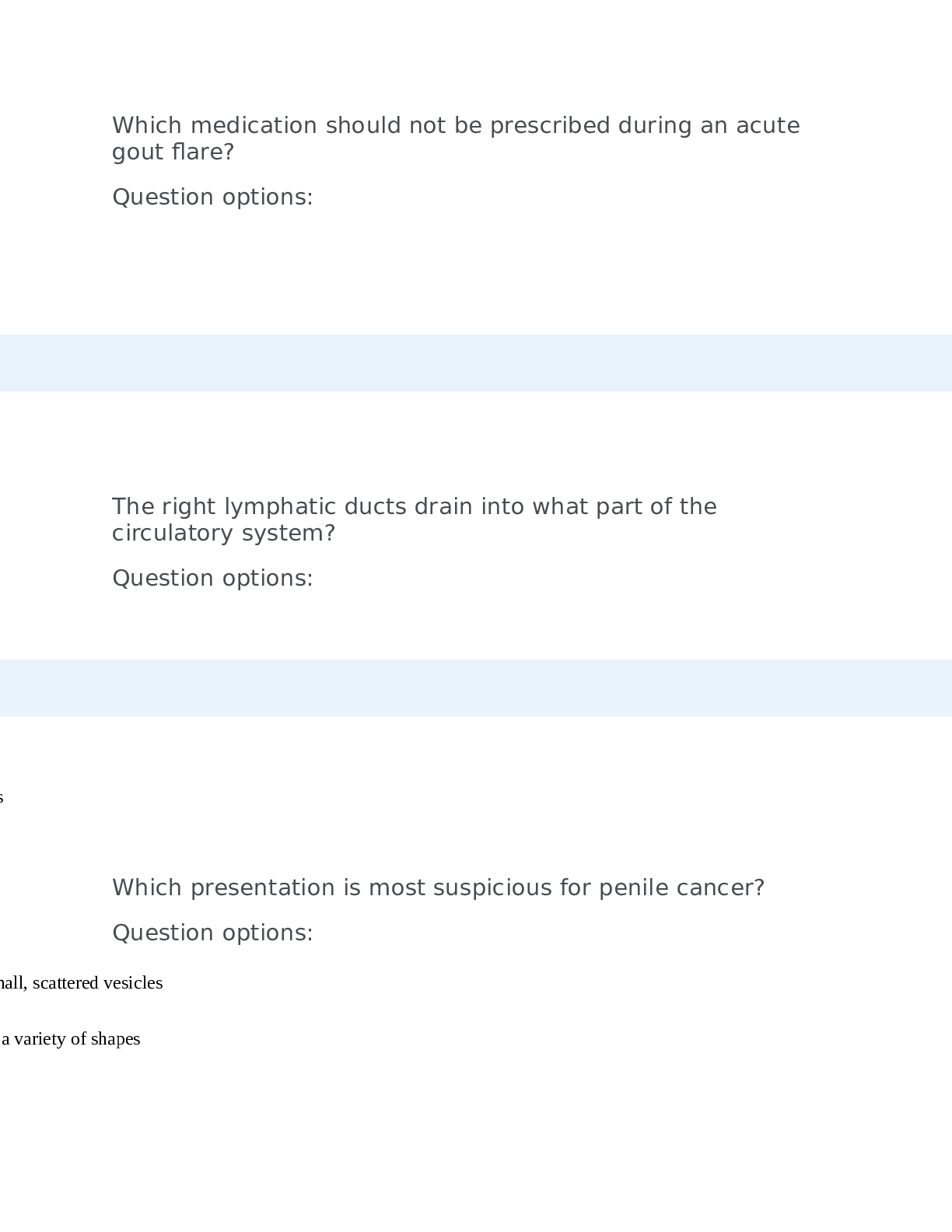
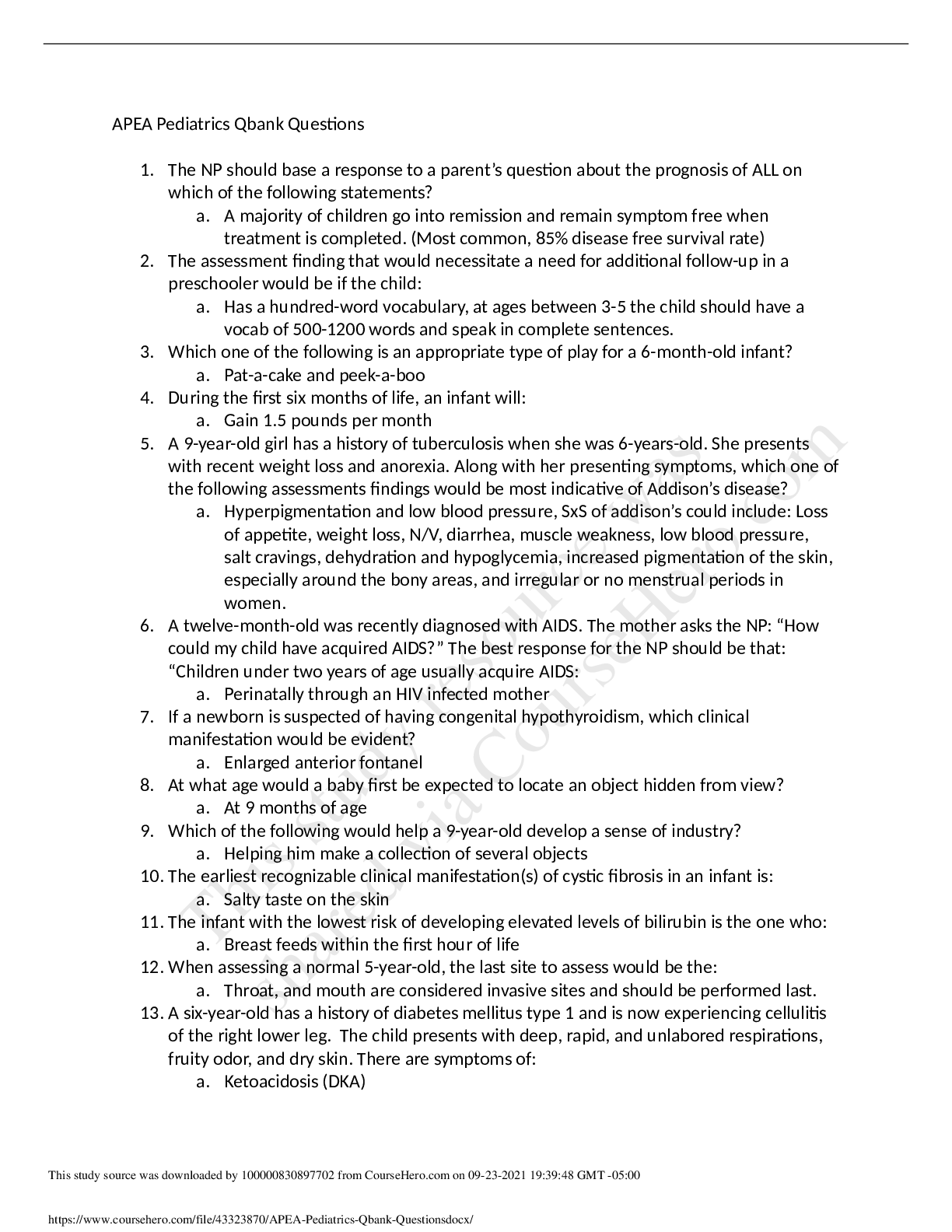

.png)
